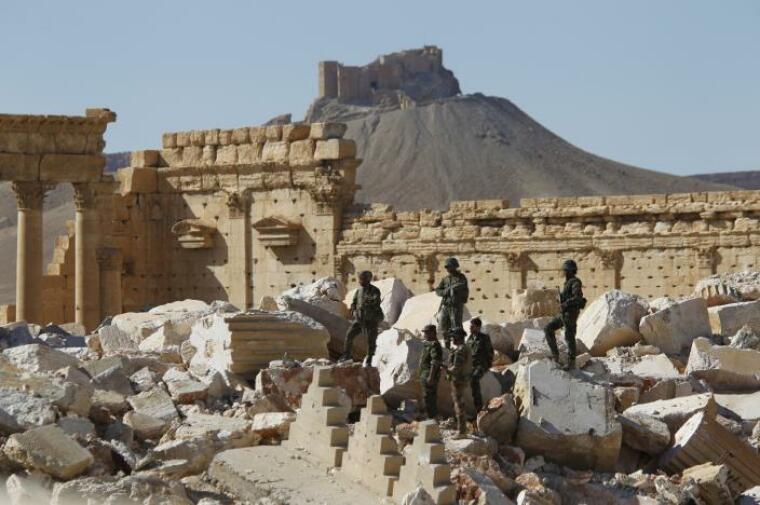Corpses of ISIS recruits and child soldiers found among ruins of Palmyra

The Islamic State has retreated from the ancient Syrian city of Palmyra, but it has left behind what has been described as the "debris of death," which consists of corpses of child soldiers and ISIS recruits.
A new video footage from the ISIS battlefield showed dead bodies of the terror group's recruits as well as its victims abandoned among the ruined tombs of the ancient city.
Russia Today's Lizzie Phelan uncovered the decapitated and charred remains of two Syrian soldiers and found two more corpses in a nearby ditch. She also described finding dozens of dead ISIS fighters, including what appeared to be child soldiers.
"From this body it is evident this fighter was a child — we can see from his hands and face, and to me he looks no older than 11 or 12," she narrated.
The crew of Russia Today has notified the Syrian government about the horrifying find, but the army does not have the resources to search the desert for remains. Deadly landmines and a threat of ISIS militants that may still be lurking nearby also prevent them from re-entering the area to retrieve the remains of the child soldiers and the terror group's victims.
This was the second time that the Syrian Arab Army pushed back the terror group from the city of Palmyra.
ISIS captured the city in May 2015 until it was forced out in March last year. The group was able to recapture the city in December last year after it was driven back by a barrage of Russian air strikes.
In January, it was reported that ISIS destroyed the Tetrapylon, a group of raised pillars near the city's entrance, and the facade of its Roman theater, where the terror group once forced locals to watch as it killed 25 soldiers.
Maamoun Abdulkarim, Syria's director of antiquities, has already moved most of the ancient statues from the city's museum to Damascus.
"This time, they don't seem to have damaged Palmyra as badly as we feared," he remarked.
Some former residents, many of whom are temporarily residing in the city of Homs, visited Palmyra this week to see if they could move back home. However, they found it impossible as there was no water or electricity.
 Christians don't have to affirm transgenderism, but they can’t express that view at work: tribunal
Christians don't have to affirm transgenderism, but they can’t express that view at work: tribunal Archaeology discovery: Medieval Christian prayer beads found on Holy Island
Archaeology discovery: Medieval Christian prayer beads found on Holy Island Presbyterian Church in America votes to leave National Association of Evangelicals
Presbyterian Church in America votes to leave National Association of Evangelicals Over 50 killed in 'vile and satanic' attack at Nigerian church on Pentecost Sunday
Over 50 killed in 'vile and satanic' attack at Nigerian church on Pentecost Sunday Ukrainian Orthodox Church severs ties with Moscow over Patriarch Kirill's support for Putin's war
Ukrainian Orthodox Church severs ties with Moscow over Patriarch Kirill's support for Putin's war Islamic State kills 20 Nigerian Christians as revenge for US airstrike
Islamic State kills 20 Nigerian Christians as revenge for US airstrike Man who served 33 years in prison for murder leads inmates to Christ
Man who served 33 years in prison for murder leads inmates to Christ


 Nigerian student beaten to death, body burned over ‘blasphemous’ WhatsApp message
Nigerian student beaten to death, body burned over ‘blasphemous’ WhatsApp message 'A new low': World reacts after Hong Kong arrests 90-year-old Cardinal Joseph Zen
'A new low': World reacts after Hong Kong arrests 90-year-old Cardinal Joseph Zen Iran sentences Christian man to 10 years in prison for hosting house church worship gathering
Iran sentences Christian man to 10 years in prison for hosting house church worship gathering French Guyana: Pastor shot dead, church set on fire after meeting delegation of Evangelicals
French Guyana: Pastor shot dead, church set on fire after meeting delegation of Evangelicals ‘Talking Jesus’ report finds only 6% of UK adults identify as practicing Christians
‘Talking Jesus’ report finds only 6% of UK adults identify as practicing Christians Mission Eurasia ministry center blown up in Ukraine, hundreds of Bibles destroyed: 'God will provide'
Mission Eurasia ministry center blown up in Ukraine, hundreds of Bibles destroyed: 'God will provide' Church holds service for first time after ISIS desecrated it 8 years ago
Church holds service for first time after ISIS desecrated it 8 years ago Burger King apologizes for 'offensive campaign' using Jesus' words at the Last Supper
Burger King apologizes for 'offensive campaign' using Jesus' words at the Last Supper Uganda: Muslims abduct teacher, burn him inside mosque for praying in Christ’s name
Uganda: Muslims abduct teacher, burn him inside mosque for praying in Christ’s name